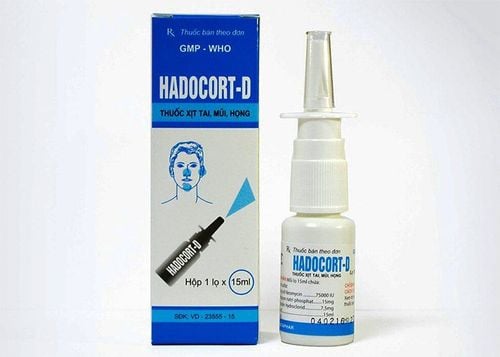This is an automatically translated article.
Hydrogen peroxide is a wound cleaner through a mechanical effervescent action, reducing bacteria and antibacterial properties. It is necessary to use Hydrogen peroxide solution with a reasonable concentration in a reasonable time to avoid unwanted effects. The following article will give you some information about the indications and how to use Hydrogen peroxide solution.
1. What is Hydrogen peroxide?
Hydrogen peroxide (also known as hydrogen peroxide) is an oxidizing agent that has antiseptic, disinfecting, wound cleaning and deodorizing effects. Hydrogen peroxide has weak antibacterial, antiviral (including HIV) and mild hemostatic activity.
Hydrogen peroxide in contact with tissue containing the enzyme catalase will release nascent oxygen with strong oxidizing properties, destroying harmful microorganisms. The mechanical action of effervescence removed tissue debris and pus to clean the wound. New oxygen release and bubbling occurs more rapidly in wounds, abraded skin, and mucosa than in healthy skin. The antibacterial activity of Hydrogen peroxide is relatively weak and slow, and the drug often penetrates poorly into wounds and tissues.
The mechanical effect of effervescence clears tissue debris and reduces the number of bacteria in the wound rather than the antibacterial effect of the drug. However, the mechanical effervescence effect only lasts for a short time when oxygen is released.
Concentrated Hydrogen peroxide solution can damage tissue, bleach hair.
Dosage form of Hydrogen peroxide:
Hydrogen peroxide solution with concentrations of 3, 6, 27 and 30%. Hydrogen peroxide gel 1.5%.
2. Indications and contraindications of Hydrogen peroxide
2.1. Indications Hydrogen peroxide is used topically, used in the following cases:
Clean wounds, disinfect and deodorize (usually 1.5 - 3% Hydrogen peroxide solution). This product is suitable for use by adults, children and the elderly. Use diluted Hydrogen peroxide solution to gargle, apply to the mouth to treat stomatitis, acute gingivitis and to eliminate bad breath (use no more than 7 days). The product is suitable for use by adults, children over 12 years old and the elderly. Due to the risk of ingestion, it should only be used by young children under the guidance of a physician. Use in combination with other disinfectants for disinfection, skin and mucous membranes. Clean the root canal and pulp cavity of the tooth. Remove earwax with ear drops. Disinfect, disinfect endoscopes, contact lenses, dialysis equipment (using 6% solution). 2.2. Contraindications Allergy or hypersensitivity to any component of Hydrogen peroxide. Hydrogen peroxide should not be injected or dripped into closed body cavities. Do not use concentrated preparations (> 35%) for any therapeutic purpose. Hydrogen peroxide should not be used in case of an abscess.
3. How to use Hydrogen peroxide solution
Drugs used externally to clean wounds or sores. Usually use Hydrogen peroxide solution with concentration of 1.5 - 3% or Gel Hydrogen peroxide concentration of 1.5%. Children under 12 years of age use Hydrogen peroxide under adult supervision.
Treatment of acute stomatitis: Use 1.5-3% Hydrogen peroxide solution to gargle or deodorize the mouth. Dilute 15 ml of 6% Hydrogen peroxide solution with warm water. Then use this mixture to gargle towards the lesion, should gargle for at least 1 minute before spitting it out. Gargle after meals and at bedtime, up to 4 times per day. Small wounds in the mouth or gums: Apply a small amount of Hydrogen peroxide 1.5% concentration to the wound, let it sit for at least one minute, then spit it out. Apply 4 times/day, apply daily. To remove earwax: drop the solution after diluting 6% Hydrogen peroxide solution with water in a ratio of 1:3. Clean contact lenses: use 3% Hydrogen peroxide solution. To avoid corneal irritation, it should be inactivated with sodium pyrurate, sodium thiosulfate, catalase or a platinum catalyst prior to use. Disinfect endoscopes: soak instruments for 30 minutes with 6% Hydrogen peroxide solution. Before use, it is necessary to wash the instrument thoroughly to completely remove residual Hydrogen peroxide, to avoid irritating the mucosa.
4. Some notes when using Hydrogen peroxide
Only use Hydrogen peroxide solution outside the wound, do not drink or inject, put into a closed body cavity.
Do not use Hydrogen peroxide to wash or rinse your mouth for a long time. Do not use for more than 7 days unless directed by a physician.
It is necessary to dilute the concentrated Hydrogen peroxide solution (27%, 30%) before use. Do not apply to the wound undiluted form.
Do not use Hydrogen peroxide solution on healing wounds as it may cause tissue damage. Concentrated Hydrogen peroxide solution has a strong potential for skin and mucosal irritation and should therefore be used with caution.
Use caution when using Hydrogen peroxide colon enemas because it can cause gas embolism, colon rupture or necrotizing enterocolitis. Some cases of local damage to the colorectal mucosa when using 3% Hydrogen peroxide for enema and due to residual Hydrogen peroxide after sterilizing rectal instruments.
Pregnant and lactating women: There is currently insufficient evidence on the safety of using Hydrogen peroxide in these subjects.
It should be noted that Hydrogen peroxide damages rubber, plastic, chromium, nickel-silver plated surfaces and has little effect on Enterovirus and Mycobacteria.
5. Hydrogen peroxide side effects
Concentrated Hydrogen peroxide solution can cause tissue damage, skin erosion. Hydrogen peroxide can cause irritation, erythema, skin stinging and itching, "burning" of the skin and mucous membranes. Less common: ulceration or atrophy of the skin, scarring, joint disease, herpes zoster infection, eyelid edema. Using Hydrogen peroxide solution as mouthwash or mouthwash for a long time, repeated many times can cause reversible enlargement of the tongue papilla. Injecting or instilling Hydrogen peroxide into a closed body cavity is dangerous because the oxygen is released with no escape route. Colonic enema with Hydrogen peroxide solution causes gas embolism, proctitis, ulcerative colitis, colon rupture, and bowel necrosis.
6. Hydrogen peroxide overdose and toxicity
Ingestion of small amounts of 3% Hydrogen peroxide usually causes only mild digestive upset. However, drinking a more concentrated solution of Hydrogen peroxide (>10%) or a large amount of 3% solution can cause complications, even death. Nerve damage in children and adults can be immediate and fatal after ingestion of a 35% hydrogen peroxide solution. Apnea, stridor, circulatory arrest, cyanosis, coma, convulsions, confusion, lethargy have been reported. Gas embolism can occur with concentrated hydrogen peroxide solutions and is especially dangerous. Gastrointestinal: vomiting, nausea, foaming at the mouth, vomiting blood may occur. The release of large amounts of oxygen in the stomach can cause abdominal pain, bloating, and belching. Blisters or mucosal burns are usually present with a solution of 30% or higher. Topical application with concentrated solution can cause blisters, erythema, purpura, necrosis in areas of the skin. Concentrations above 10% may cause corneal ulceration in contact with eyes.
7. Interactions with other drugs
Currently, there is no interaction of Hydrogen peroxide solution for external use with other drugs.
Drug incompatibility: Do not let Hydrogen peroxide solution come into contact with oxidizing or reducing agents, because it may lead to decomposition.
In short, Hydrogen peroxide (also known as hydrogen peroxide) is an oxidizing agent, which has antiseptic, disinfecting, wound cleaning and deodorizing effects. Hydrogen peroxide has weak antibacterial, antiviral and hemostatic activity.
Follow Vinmec International General Hospital website to get more health, nutrition and beauty information to protect the health of yourself and your loved ones in your family.
Please dial HOTLINE for more information or register for an appointment HERE. Download MyVinmec app to make appointments faster and to manage your bookings easily.













